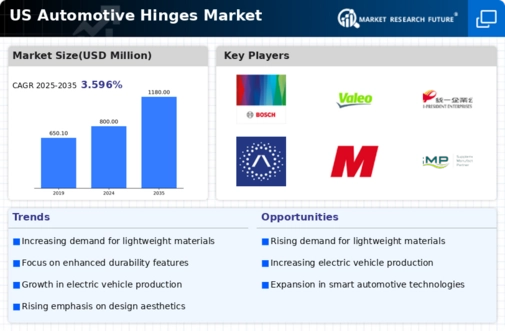Rising Vehicle Production
The automotive hinges market is experiencing growth driven by the increasing production of vehicles in the United States. In 2025, the production of light vehicles is projected to reach approximately 15 million units, reflecting a steady demand for automotive components. This surge in vehicle manufacturing necessitates a corresponding increase in the supply of automotive hinges, which are essential for door and trunk operations. As manufacturers strive to enhance vehicle functionality and design, the demand for innovative hinge solutions is likely to rise. Furthermore, the automotive hinges market is expected to benefit from the expansion of electric vehicle production, which often requires specialized hinge designs to accommodate unique body structures. This trend indicates a robust market environment for hinge manufacturers, as they adapt to the evolving needs of the automotive sector.
Growing Demand for Customization
The automotive hinges market is witnessing a growing demand for customization as consumers increasingly seek personalized vehicle features. This trend is particularly evident in the luxury and performance vehicle segments, where unique hinge designs can enhance aesthetic appeal and functionality. Manufacturers are responding to this demand by offering a wider range of hinge options, including various materials, finishes, and designs tailored to specific vehicle models. In 2025, it is projected that the customization segment of the automotive hinges market could account for approximately 15% of total sales, reflecting a shift towards more individualized vehicle components. This trend not only benefits consumers but also presents opportunities for manufacturers to differentiate their products in a competitive market. The automotive hinges market is thus adapting to these preferences, fostering innovation and creativity in hinge design.
Increased Focus on Sustainability
The automotive hinges market is increasingly influenced by a heightened focus on sustainability within the automotive industry. As manufacturers strive to reduce their environmental impact, there is a growing emphasis on using eco-friendly materials and processes in the production of automotive components, including hinges. In 2025, it is anticipated that the market for sustainable automotive parts could grow by 25%, driven by consumer demand for greener vehicles. This shift towards sustainability is prompting hinge manufacturers to explore alternative materials, such as recycled metals and bioplastics, which can reduce the carbon footprint of their products. The automotive hinges market is thus evolving to meet these sustainability goals, aligning with broader trends in the automotive sector that prioritize environmental responsibility.
Regulatory Compliance and Safety Standards
The automotive hinges market is significantly impacted by stringent regulatory compliance and safety standards imposed by government agencies. In the United States, regulations regarding vehicle safety and performance are becoming increasingly rigorous, necessitating that manufacturers ensure their products meet these standards. This has led to a greater emphasis on the quality and reliability of automotive hinges, as they play a critical role in vehicle safety. In 2025, it is expected that compliance-related costs could account for up to 10% of total production expenses for hinge manufacturers. Consequently, the automotive hinges market is likely to see increased investment in research and development to create hinges that not only comply with safety regulations but also enhance overall vehicle performance. This focus on compliance is essential for manufacturers aiming to maintain market competitiveness.
Technological Advancements in Manufacturing
The automotive hinges market is significantly influenced by advancements in manufacturing technologies. Innovations such as automation, 3D printing, and precision engineering are enhancing the production processes of automotive hinges. These technologies allow for the creation of more complex and lightweight hinge designs, which can improve vehicle performance and reduce overall weight. In 2025, it is estimated that the adoption of advanced manufacturing techniques could lead to a reduction in production costs by up to 20%, thereby making it more feasible for manufacturers to invest in high-quality hinge solutions. Additionally, the automotive hinges market is likely to see increased competition as new players enter the market, leveraging these technologies to offer innovative products. This competitive landscape may drive further advancements and improvements in hinge design and functionality.





















Leave a Comment